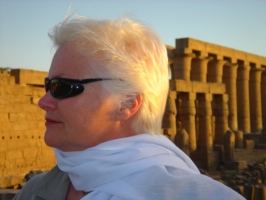She was a woman I’ve admired my whole life. Her first name was Helen, like mine, and her mother’s name was Helen, just like mine. She was called by her middle name, like I am. And boy could she draw.
She collected fossils and enjoyed categorizing them. She also drew several hundred paintings of mushrooms, lichens, and other botanicals. Her paper, “On the Germination of the Spores of Agaricineae [now known as Flammulina velutipes], proposed her theory of how fungi spores are reproduced. It was presented at a meeting of Linnean Society in 1897 by a man, since women were not allowed at meetings.
Potter’s family often stayed in the Near Sawrey area for their holidays, and their coachman would lodge at a nearby farm, Hill Top (shown at right). The house is an example of “Lakeland vernacular architecture” with random stone walls and a slate roof.
Potter bought Hill Top Farm in 1905 with the profits from publishing her children’s book The Adventures of Peter Rabbit. She wrote more books here, inspired by the area’s people and places. My travel companions and I were the only tourists there that muddy November. We also walked along Esthwaite Water, a small lake where Beatrix and her lawyer-boyfriend William Heelis walking during their courting days. Hill Top was indeed on the top of a hill, purchased when Potter was 40 years old. She then married Heelis when she was 47, and they lived together for 30 years on Hill Top and Castle Cottage (across the road from Hill Top and their primary residence). Beatrix died in 1943, and Heelis died two years later.
Her life was portrayed in the 2006 movie Miss Potter, where Potter was played as a child by Lucy Boynton and as an adult by Renee Zellweger. I rewatched the VHS version at my B&B in York. Her relationship with Norman Warne was at the center of the movie. Warne died in 1905 at age 37 (and when Beatrix was 39) from leukemia. She was lonely and sad for many years until courting and eventually marrying William Heelis, though her letters reveal she continued to pine for Warne the rest of her life.
Raised and educated by a number of governesses, Potter was encouraged early to draw and paint. While summering in 1893 with her mother and father in Scotland, Potter had written a letter to Noel Moore, the 5-year-old son of her former governess Annie, when he was ill with the mumps. That letter morphed into a book, The Adventures of Peter Rabbit.
The Beatrix Potter Garden is in the rear of the Birnam Arts Conference Centre in the village of Birnam, Perthshire. It includes sculptures of many of Potter’s characters, from Jemima Puddleduck to Mrs. Tinky Wiggle to Mr. Tod the Fox (at right), and of course Peter Rabbit and his family.
Birnam is on the River Tay. West of Birnam is the village of Killin on the western end of Loch Tay. (The River Tay flows east from the loch). Alexander Mitchell, my sons’ great-great-grandfather (and the source of Sam’s middle name) was a sheep shearer for the flocks around Killin. Iron Age inhabitants of Loch Tay lived on artificial islands (“crannogs”) built in the loch. There are at least 18 crannog settlements known in Loch Tay, more than in any other place in Scotland.*
Though some of the Mitchell ancestors may have arrived from France after the Norman invasion of 1066, some ancestors could also have been those Celtic crannog dwellers. Mitchell immigrated to Canada and sheared sheep there until moving south to Idaho. Sam’s father and I took Sam to visit Killin in 1983, when he was seven months old. There were lots of sheep! We could easily imagine Alexander Mitchell making a living in the area.
Upon her death in 1943, Beatrix Potter left most of her property to the National Trust, including over 4,000 acres of land, sixteen farms, cottages, herds of cattle, and flocks of Herdwich (“Herdy”) sheep, such as those at right.
Potter is also featured in the eight-book series of mysteries by Susan Wittig Albert called The Cottage Tales of Beatrix Potter, including Book One, The Tale of Hill Top Cottage.
* The Scottish Crannog Centre is located on the eastern end of Loch Tay. Its replica of an Iron Age Roundhouse, a structure typically built of stone, wooden posts, and wattle-and-daub panels, burned down on June 12, 2021. The Centre plans to rebuild.

Post a Comment